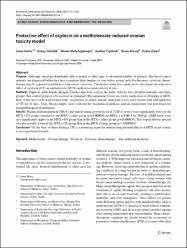| dc.contributor.author | Hortu, İsmet | |
| dc.contributor.author | Özçeltik, Gökay | |
| dc.contributor.author | Ergenoğlu, Ahmet Mete | |
| dc.contributor.author | Yiğittürk, Gürkan | |
| dc.contributor.author | Atasoy, Özüm | |
| dc.contributor.author | Erbaş, Oytun | |
| dc.date.accessioned | 2020-11-20T14:39:37Z | |
| dc.date.available | 2020-11-20T14:39:37Z | |
| dc.date.issued | 2020 | |
| dc.identifier.issn | 0932-0067 | |
| dc.identifier.issn | 1432-0711 | |
| dc.identifier.uri | https://doi.org/10.1007/s00404-020-05534-1 | |
| dc.identifier.uri | https://hdl.handle.net/20.500.12809/515 | |
| dc.description | Özçeltik, Gökay/0000-0003-1413-685X | en_US |
| dc.description | WOS: 000524622800003 | en_US |
| dc.description | PubMed ID: 32266527 | en_US |
| dc.description.abstract | Purpose Although cancer predominantly affects people at older ages, a substantial number of patients, like breast cancer patients, are diagnosed before they have completed their families or even before giving birth. Furthermore, cytotoxic chemotherapy may be required in addition to treat cancer survivors. The present study was conducted to investigate the protective effect of oxytocin (OT) on methotrexate (MTX)-induced ovarian toxicity in rats. Methods Eighteen adult female Sprague-Dawley rats were used in the study. All rats were divided randomly into three groups. The control group (n = 6) received no treatment. The remaining 12 rats received a single dose of 20 mg/kg of MTX. Half of the rats (n = 6) were treated with 1 mg/kg/day of saline, and the other half (n = 6) were treated with 160 mu g/kg/day of OT for 21 days. Then, blood samples were collected for biochemical analysis, and an ovariectomy was performed for histopathological examination. Results Plasma malondialdehyde (MDA) and transforming growth factor-beta (TGF-beta) levels were significantly lower in the MTX + OT group compared to the MTX + saline group (p = 0.000036 for MDA; p = 0.0044 for TGF-beta). AMH levels were also significantly higher in the MTX + OT group than in the MTX + saline group (p = 0.000036). The ovarian fibrosis percent was also notably lower in the MTX + OT group than in the MTX + saline group (p = 0.000036). Conclusion On the basis of these findings, OT is a promising agent for ameliorating harmful effects of MTX on rat ovaries in an experimental model. | en_US |
| dc.item-language.iso | eng | en_US |
| dc.publisher | Springer Heidelberg | en_US |
| dc.item-rights | info:eu-repo/semantics/openAccess | en_US |
| dc.subject | Methotrexate | en_US |
| dc.subject | Ovarian Damage | en_US |
| dc.subject | Oxytocin | en_US |
| dc.subject | Cytotoxic Chemotherapy | en_US |
| dc.subject | Anti-Mullerian Hormone | en_US |
| dc.title | Protective effect of oxytocin on a methotrexate-induced ovarian toxicity model | en_US |
| dc.item-type | article | en_US |
| dc.contributor.department | MÜ, Tıp Fakültesi, Temel Tıp Bilimleri Bölümü | en_US |
| dc.contributor.institutionauthor | Yiğittürk, Gürkan | |
| dc.identifier.doi | 10.1007/s00404-020-05534-1 | |
| dc.identifier.volume | 301 | en_US |
| dc.identifier.issue | 5 | en_US |
| dc.identifier.startpage | 1317 | en_US |
| dc.identifier.endpage | 1324 | en_US |
| dc.relation.journal | Archives of Gynecology and Obstetrics | en_US |
| dc.relation.publicationcategory | Makale - Uluslararası Hakemli Dergi - Kurum Öğretim Elemanı | en_US |


















